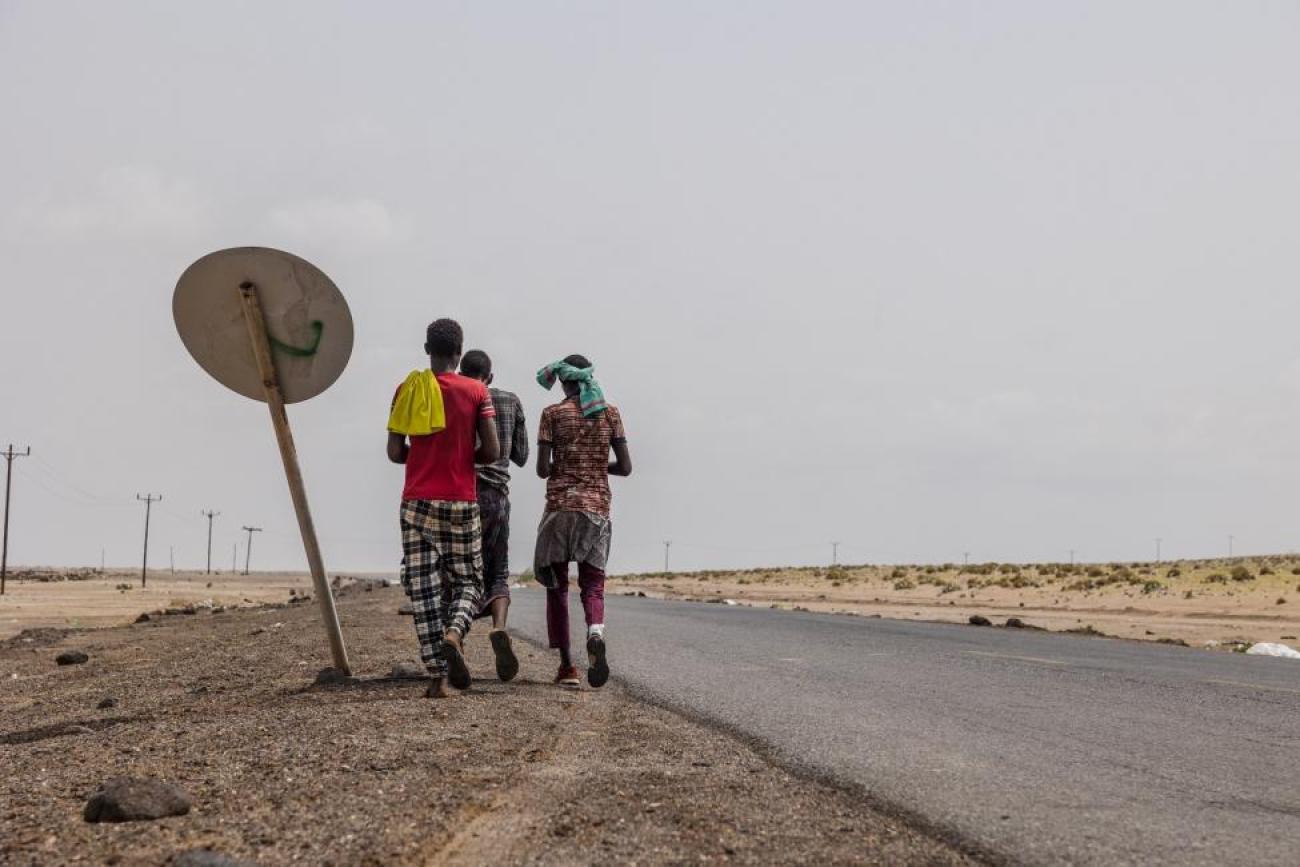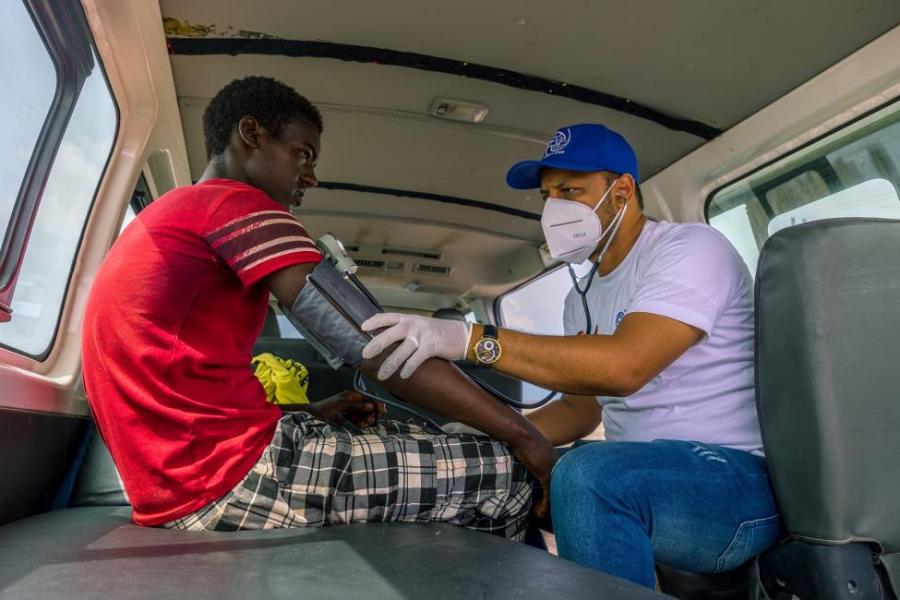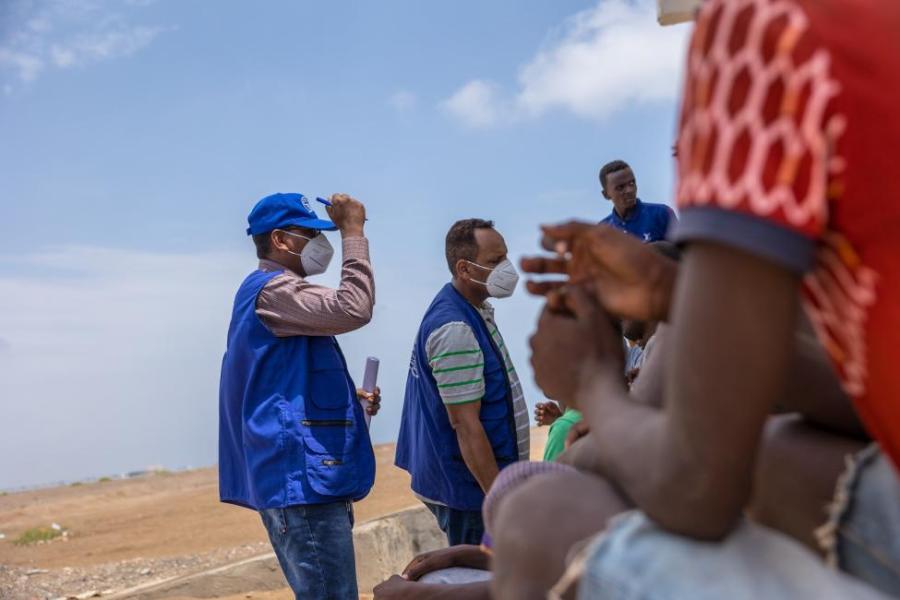IOM YEMEN: HEALTH CARE HEROES HIT THE ROAD TO RESPOND TO MIGRANTS IN DISTRESS

Aden
For the past nine years, Dr. Yasser has been a committed doctor with the International Organization for Migration (IOM). His patients: migrants and displaced people in conflict-torn Yemen. First, he worked to serve communities in the governorates in the south of the country: Shabwah, Abyan and Ad Dhale’. A year later, he took his practice on the road as part of IOM’s mobile medical clinics, which provide emergency care for migrants walking through barren areas of Yemen along Yemen’s southern coastline.
During the first few days working in a mobile clinic, Dr. Yasser recalls feeling “traumatized by the cases we found along the road during our daily journey.”
“There were so many migrants that we came across who were severely tortured and in terrible conditions,” he adds.
The migrants Dr. Yasser serves are traveling along what is known as the ‘Eastern Route’ - the second busiest maritime migration route in the world that spans the Horn of Africa to Yemen, a country in its ninth year of conflict.
Tens of thousands of migrants make this perilous journey each year – transiting first on foot through the Horn of Africa and then by boat to the shores of Yemen – in hopes that the risky journey will take them into a brighter future once they reach their final destinations in the Gulf countries.
Health Care: on the Move Mobile Medical Clinics Save Lives Along Yemen Migration Routes
In the first seven months of 2023, over 86,000 migrants have crossed the Gulf of Aden to Yemen according to IOM’s Displacement Tracking Matrix, already exceeding last year’s total figures.
“Many of the migrants we meet suffer from skin, respiratory or digestive problems. Migrants who need further medical attention and psychosocial support are rushed to IOM’s Migrant Response Point or health facilities supported by IOM in Aden,” Dr. Yasser says.
The clinic patrols daily in search of migrants in distress who have recently landed by boat along the country’s coastal areas. For many migrants who arrive at Yemen’s shores, Dr. Yasser’s team is the first people who lend them a helping hand.
“Our team consists of a doctor, a nurse, a pharmacist, a translator and a driver,” he says, adding that they help an average of 150 migrants every week.
Every day, the team drives 370 kilometres round trip from the city of Aden to areas along the coast, where public services and infrastructure to receive migrants are non-existent.
Migrants are some of the most vulnerable and at-risk groups in Yemen. They arrive with little more than the clothes on their back. They can rarely afford food, shelter or transport fees, let alone medicine and other medical costs.
“My father – and my family’s provider – died ten years ago. I worked as a farmer back home, but it was barely enough to feed myself,” says Obsan*, a young Ethiopian migrant who came to Yemen with the intention of reaching the Gulf countries to find work.
Like Obsan, many of the migrants arriving to Yemen leave their countries to escape poverty and sometimes conflict. Most are unaware they will be transiting through a country affected by years of conflict itself.
“My family could not pay for my education, so I had to drop out of school twice. I did not even have money to buy a pen or a notebook,” adds Obsan.

Dr. Yasser and his team bear the long daily hours of travel because they know their work can be lifesaving for people on the move.
“I recall in 2019 when cholera broke out, many migrants were suffering severely when we found them. One day, we found four young migrants under a tree who were close to dying of cholera. Luckily the team worked fast to revive them, and we were able to save them.”
“If we had arrived only 15 minutes later, they could have died. Saving them was very rewarding,” recalls Dr. Yasser.

Most migrants that arrive in Yemen are under 30 years old; some are as young as nine or ten. After what many have experienced on their journey, these migrants often feel scared when the mobile clinic first approaches.
“Some migrants are afraid that we will kidnap them, but they soon feel relieved when we explain with a smile that we are humanitarians,” explains Dr. Yasser.
“A flicker of hope shines through their tired faces as we provide health care. Seeing these people safe and in good health is our greatest reward.”
On World Humanitarian Day, we salute all humanitarians who stand shoulder to shoulder with the communities they serve, no matter who, no matter where, no matter what.
The mobile clinic that patrols areas in Lahj are operational thanks to funding from the European Union, the US State Department’s Bureau of Population, Refugees and Migration, and the government of Germany.
Other mobile medical clinics serving migrants and displaced populations in Shabwah, Al Hodeidah and Ma’rib governorates are supported by the USAID's Bureau for Humanitarian Assistance (BHA), the United Nations Central Emergency Relief Fund, the Yemen Humanitarian Fund, and the Governments of Japan and Finland.
IOM’s humanitarian assistance and protection services in response to the needs of the returnees are aligned with the Regional Migrant Response Plan for the Horn of Africa and Yemen 2023, which aims to address the needs of migrants in vulnerable situations and host communities in countries situated along the Eastern Migratory Route, located between the Horn of Africa and Yemen.
*Some names changed to protect identities


